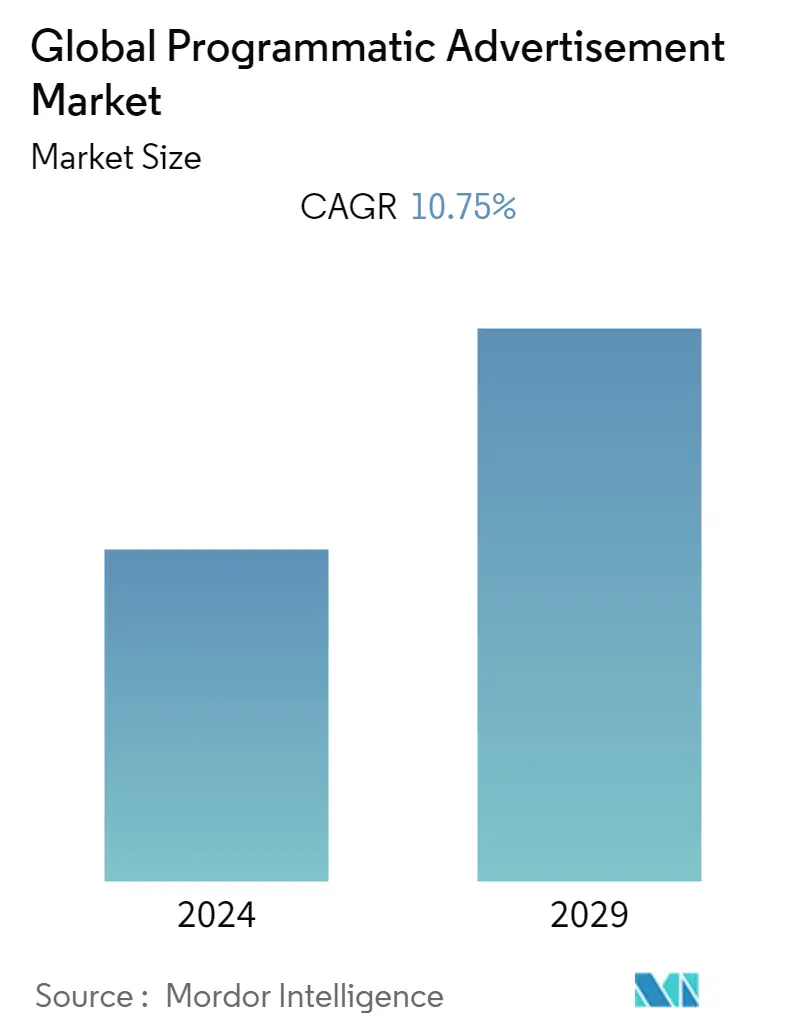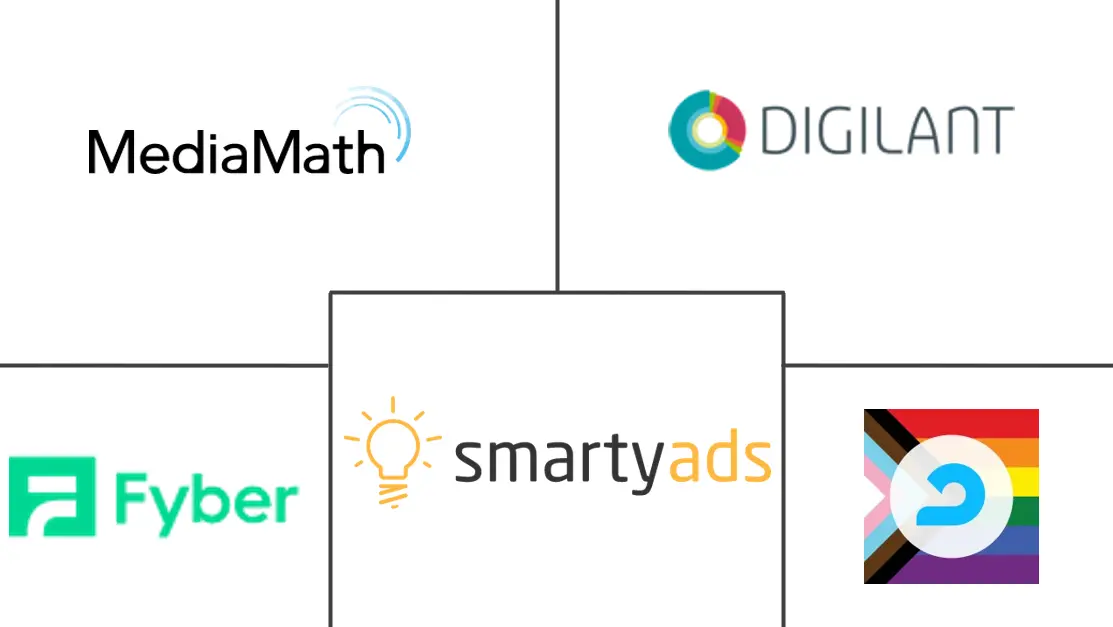Market Size of Global Programmatic Advertisement Industry

| Study Period | 2019 - 2029 |
| Base Year For Estimation | 2023 |
| CAGR | 10.75 % |
| Fastest Growing Market | Asia-Pacific |
| Largest Market | North America |
| Market Concentration | Low |
Major Players
*Disclaimer: Major Players sorted in no particular order |
Programmatic Advertisement Market Analysis
Over the projected period, the Programmatic Advertisement Market is expected to grow at a CAGR of 10.75% (2022 - 2027). Huge technological advancements, as well as an increasing focus on more precise audience targeting and assessment, are propelling programmatic advertising forward.
- Advertisers expect better performance and capabilities from the advertising technology they use. Content publishers and brand owners may utilise programmatic advertising to locate and apply the relevant messages to improve the value and effectiveness of a viewer's digital out-of-home advertising experience.
- Before programmatic ad buying, ad agencies negotiated and offered digital ad slots, which media buyers subsequently purchased through a time-consuming and expensive procedure. By removing pointless steps from the process and giving some human responsibilities to robots, programmatic advertising improves the efficiency and cost-effectiveness of the ad purchasing system.
- The automated purchasing, selling, and delivery of Digital Out-of-Home (DOOH) advertising space is referred to as programmatic DOOH. As with other internet advertising, programmatic DOOH automates the sale and distribution of ad material. Buyers can use programmatic transactions to create precise conditions that, if satisfied, will result in the purchase of a DOOH advertising slot.
- Moreover, the use of automation and machine learning technology to purchase and show digital advertisements to segmented audiences in real-time is projected to climb drastically over the next three years, according to research conducted in 2021 from ALFI, an AI enterprise SaaS advertising platform.
- Programmatic advertising provide various benefits, including real-time insights into the effectiveness of ad campaigns, enhanced targeting capabilities, increased transparency on ad inventory, improved budget usage, and effective ad fraud management, all of which helps to drive the market. On the other hand, a lack of understanding of programmatic advertising expenditure is expected to hamper industry growth during the projection period.
- When the first wave of COVID-19 hit in March, according to an IAB analysis, brands cut spending by up to 30% overnight, with one in four suspending activity completely. Many expected that the consequences will be far worse than the financial crisis of 2008. As approached to the end of 2020, the majority of businesses have cut, or in some cases, ceased, their advertising expenditures.
Programmatic Advertisement Industry Segmentation
Programmatic Advertising is the utilization of software to buy digital advertising. This automation makes transactions efficient and more effective, streamlining the process and consolidating your digital advertising efforts in one technology platform.
The Global Programmatic Advertisement Market is segmented By Trading Platform (Real Time Bidding, Private Marketplace Guaranteed, Automated Guaranteed and Unreserved Fixed-rate), By Advertising Media (Digital Display and Mobile Display), By Enterprise size (SMB's and Large Enterprises) and By Geography. The scope of the study tracks the imact of covid-19 on the studied market.
| By Trading Platform | |
| Real Time Bidding (RTB) | |
| Private Marketplace Guaranteed | |
| Automated Guaranteed | |
| Unreserved Fixed-rate |
| By Advertising Media | |
| Digital Display | |
| Mobile Display |
| By Enterprise size | |
| SMB's | |
| Large Enterprises |
| By Geography | |
| North America | |
| Europe | |
| Asia-Pacific | |
| Latin America | |
| Middle East & Africa |
Global Programmatic Advertisement Market Size Summary
The global programmatic advertisement market is experiencing significant growth, driven by technological advancements and a heightened focus on precise audience targeting. This evolution is transforming the advertising landscape, allowing content publishers and brand owners to enhance the value and effectiveness of digital out-of-home advertising. Programmatic advertising streamlines the ad purchasing process by automating the buying, selling, and delivery of ad space, thereby improving efficiency and cost-effectiveness. The integration of automation and machine learning technologies is expected to further boost the market, enabling real-time insights, enhanced targeting, and improved budget utilization. Despite these advancements, a lack of understanding regarding programmatic advertising expenditure poses a challenge to industry growth.
The market's expansion is also fueled by the increasing importance of mobile advertising, particularly through real-time bidding (RTB), as consumers engage with digital content across various platforms. The COVID-19 pandemic accelerated the shift towards digital media, with brands reallocating their marketing budgets to capitalize on the growing number of digital consumers. This shift has led to a surge in digital ad revenues, with significant growth observed in digital video, audio, social media, and search advertising. The emergence of new businesses further drives demand for programmatic advertising, as these companies seek to reach consumers in an increasingly digital world. However, the complexity and uncertainty surrounding programmatic advertising continue to challenge marketers, necessitating ongoing innovation and strategic partnerships within the industry.
Global Programmatic Advertisement Market Size - Table of Contents
-
1. MARKET INSIGHTS
-
1.1 Market Overview
-
1.2 Industry Value Chain Analysis
-
1.3 Industry Attractiveness-Porter's Five Force Analysis
-
1.3.1 Bargaining Power of Suppliers
-
1.3.2 Bargaining Power of Buyers/Consumers
-
1.3.3 Threat of New Entrants
-
1.3.4 Threat of Substitute Products
-
1.3.5 Intensity of Competitive Rivalry
-
-
1.4 Impact of COVID-19 on the Global Programmatic Advertising Market
-
-
2. Market Segmentation
-
2.1 By Trading Platform
-
2.1.1 Real Time Bidding (RTB)
-
2.1.2 Private Marketplace Guaranteed
-
2.1.3 Automated Guaranteed
-
2.1.4 Unreserved Fixed-rate
-
-
2.2 By Advertising Media
-
2.2.1 Digital Display
-
2.2.2 Mobile Display
-
-
2.3 By Enterprise size
-
2.3.1 SMB's
-
2.3.2 Large Enterprises
-
-
2.4 By Geography
-
2.4.1 North America
-
2.4.2 Europe
-
2.4.3 Asia-Pacific
-
2.4.4 Latin America
-
2.4.5 Middle East & Africa
-
-
Global Programmatic Advertisement Market Size FAQs
What is the current Global Programmatic Advertisement Market size?
The Global Programmatic Advertisement Market is projected to register a CAGR of 10.75% during the forecast period (2024-2029)
Who are the key players in Global Programmatic Advertisement Market?
War Room Holdings, Inc, MediaMath, Digilant, Fyber N.V. and SmartyAds are the major companies operating in the Global Programmatic Advertisement Market.

